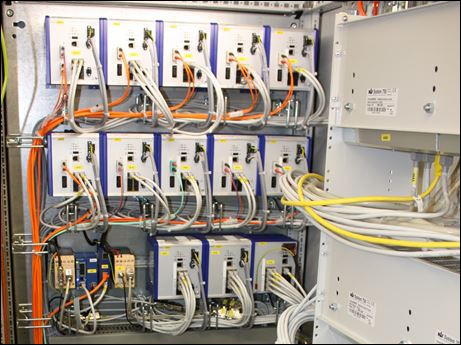Les commutateurs Ethernet industriels modernisent les sous-stations selon la norme CEI 61850
Dans le monde entier, les opérateurs d'énergie électrique cherchent à augmenter la fiabilité, la résilience et la capacité avec des investissements intelligents dans les nouvelles technologies. This includes Stadtwerke Karlsruhe Netzservice GmbH (SWKN), the municipal utility that provides electricity, gas, water and heating to the 300,000 inhabitants of the city of Karlsruhe in southwestern Germany.
In conjunction with replacing primary electric transmission equipment with new gas insulated switchgear (GIS), SWKN wanted to improve the reliability of its substations. Doing so included upgrading the control and automation system from legacy protocols to the IEC 61850 communication standard.
The utility partnered with a local energy systems integrator, IDS Group, who provided a new substation control and protection system, including the communications network. Critical aspects of the network were redundancy at the substation level and fast integration of IDS's bay control units.
There is a lot than can be learned from this real-life example of how a utility updated its systems for real-time monitoring and control, aligning with the vision of the Smart Grid. Let’s take a look at how they did it.

To meet the growing electricity demands of the city of Karlsruhe, Germany three substations were upgraded. Hirschmann switches were key components of the new two-way communication infrastructure.
Stadtwerke Karlsruhe Substation Design Requirements
The power grid of SWKN covers 65km2 and provides household electricity plus energy for critical infrastructure including a hospital and regional railway system.
To meet increasing power consumption requirements, as well as to improve reliability, SWKN decided to update their substations with modern GIS that improves the quality of voltage regulation and reduces losses.
The project involved updating the largest substation (West) as well as two other substations (Blöße and Heide). At Substation-West, the goal was to completely renew the existing 110kV outdoor primary equipment with SF6 GIS. In addition, a new Substation Automation System (SAS) was required to protect, monitor and control the switchgear operations for all three substations.
Unique requirements for the substation communication infrastructure were:
- High performance for handling large – and growing – data volumes
- Two-way communication between the control center and substations; Conversion of substation IEC 61850 transmissions to control center IEC 870-5-104 (IEC 104) transmissions and vice versa
- IEC 61850 compliance for a future-proof investment; use of this standard allows the utility to change, update and expand the system using interoperable equipment from a variety of manufacturers
- A redundant communication infrastructure at each substation for enhanced reliability
- Ease and security of remote connectivity
High Performance Ethernet Switches Update Substations to IEC 61850
IDS Systems created network architecture for each substation that includes two identically designed and redundant central processing units with SCADA gateways (IDS ACOS 750 SAS). These devices communicate to the control center using the IEC 104 protocol and to the substations using the IEC 61850 protocol. They also control all the general functions of the substation and system redundancy.
The type of information exchanged includes metering, status change, event and fault data from the substations to the control center and control information out to the substations.
The SCADA gateways communicate with Hirschmann switches that are connected to Intelligent Electronic Devices (IEDs) using a ring topology. There are five rings per 20kV level and one ring for the 110kV level. This topology guarantees enough bandwidth for communication amongst devices in the same bay and delivers faster reconfiguration times in case the communication is broken at any point of the ring.
Only communications between devices in different bays and between devices in one bay and the control center pass through the main switches, reducing the loads and allowing sufficient bandwidth when a fast event (GOOSE) needs to be transmitted. Communication between different voltage levels is also limited to mission-critical application traffic.

Inside Stadtwerke Karlsruhe Substation-West showing Hirschmann RSR Switches on the left and IDS Bay Controllers, incorporating Hirschmann Embedded Ethernet Switches, on the right.
Click here for a network diagram of this substation.
Belden provided two key components of the final solution. One component is embedded Ethernet switches (EES) for the SCADA gateways. These switches provide an easy way to add network connectivity into field devices. Using tested, high quality switching components also reduces risk and development costs and speeds up the project. The Hirschmann EES modules also include built-in support for redundancy protocols for an immediate improvement in reliability.
The second component is managed industrial Ethernet switches which are DIN rail mounted. These switches meet the SWKN project requirements including Gigabit Ethernet connectivity, very high environmental tolerances and long, maintenance-free life cycles.
IEC 61850 Substation Communication Design
This project shows how it's possible to update substations from communicating via serial or legacy protocols to modern technologies based on TCP/IP such as IEC 61850 or IEC 104. In this case SWKN went from using a mix of different protocols, including proprietary ones, to communicating via standardized future-proof protocols.
The use of Hirschmann managed and embedded industrial Ethernet switches not only addressed the complex switching requirements but delivered built-in redundancy and security capabilities. They played a significant role in the update and instantly delivered a higher level of safety and reliability than was possible with older substation technologies.
This is a real-life example of how a utility can phase in migration to the Smart Grid vision of real-time monitoring / control and quick rerouting of power transmission as required.
